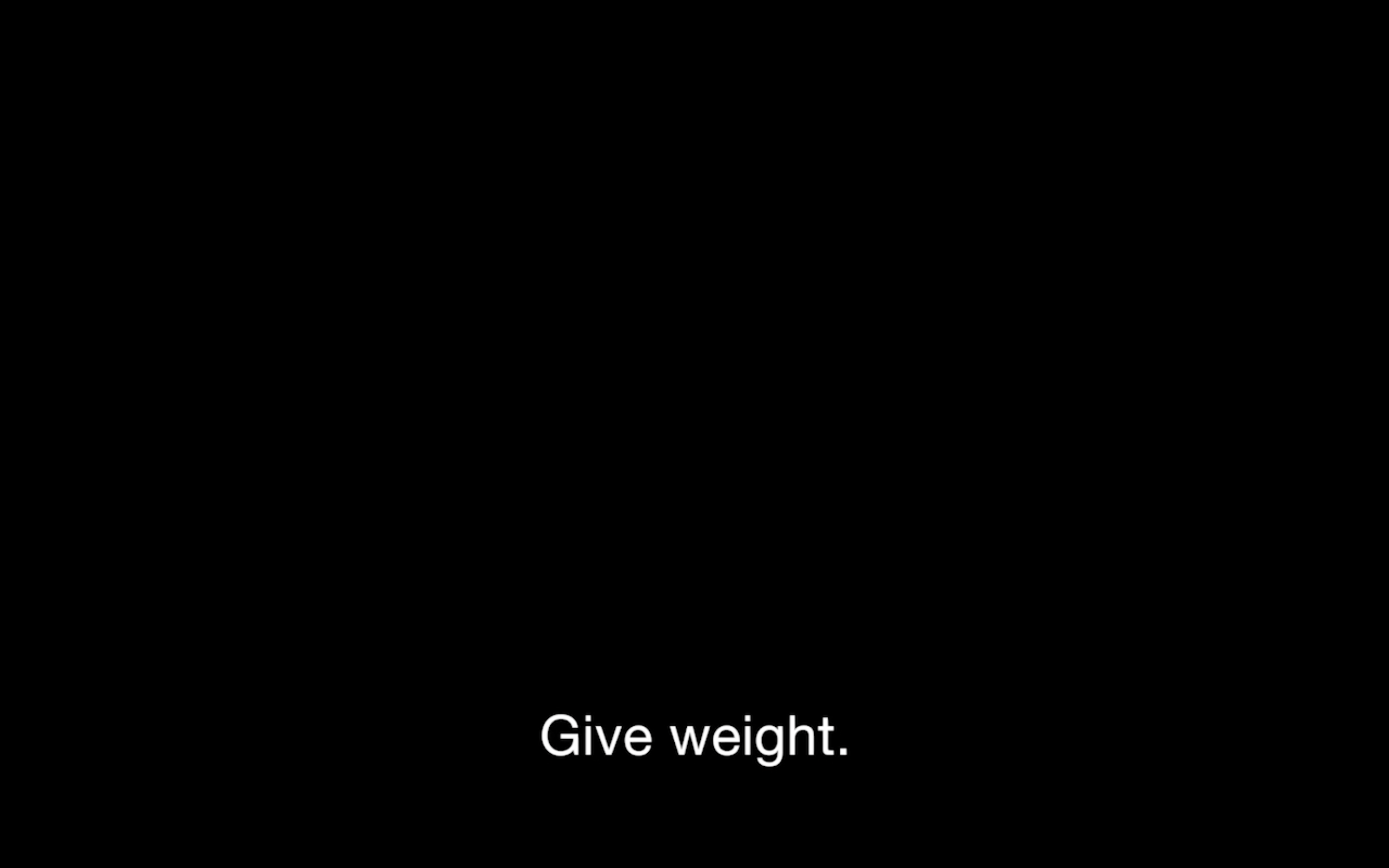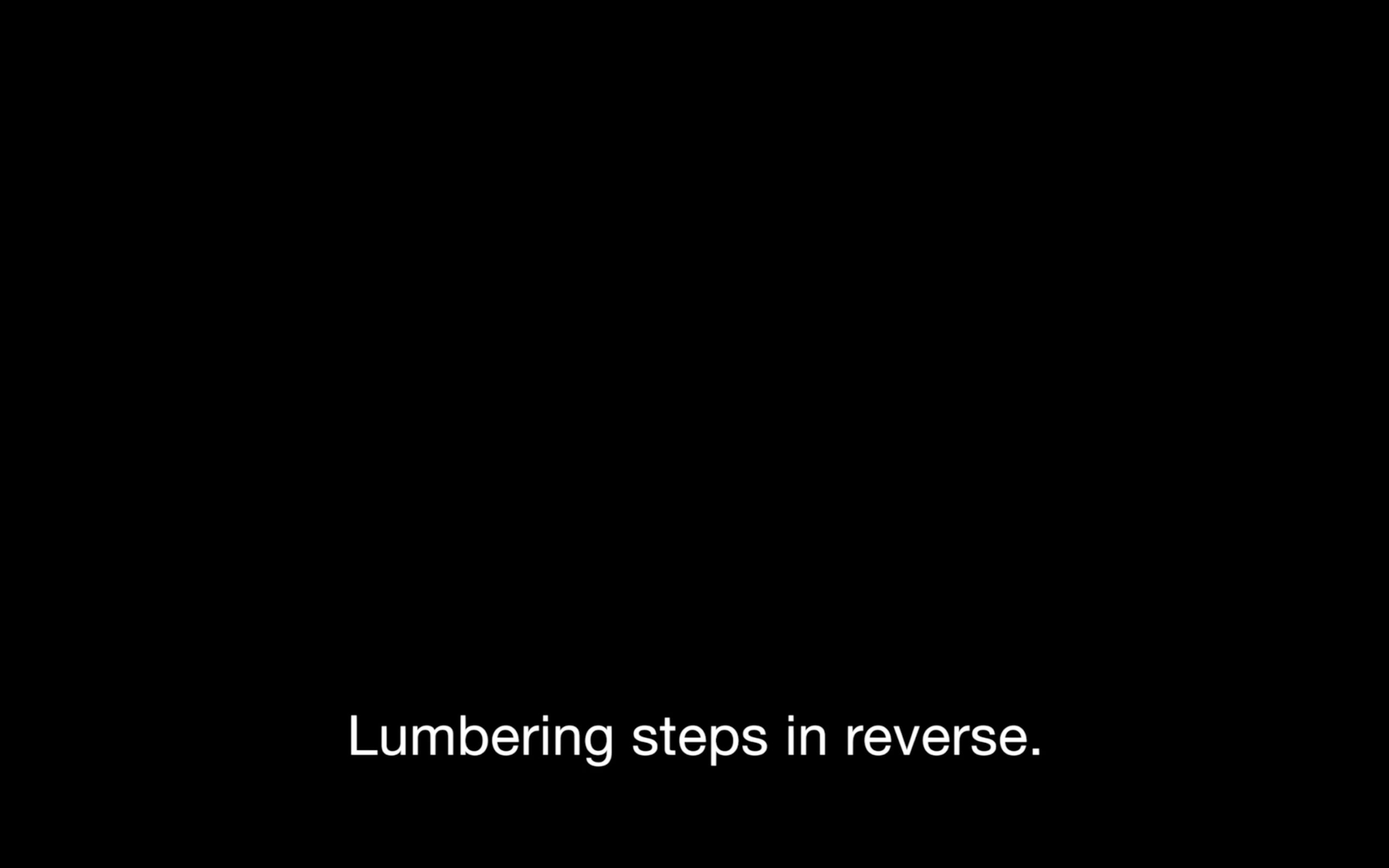Carolyn Lazard: Long Take
Carolyn Lazard, Leans, Reverses (still), 2022 [courtesy of the artist and Nottingham Contemporary, United Kingdom]
Share:
The dancer is not present
In a dark room, a white spotlight hits a vacant dance floor. Three channels of audio play on a loop: a recorded reading of a dance score; the sound of a dancer’s movement and breath; and an audio-description of the performance. Three conjoined monitors in the center of the gallery display captions of the sound and speech in white text against a black background. The dancer is not present—at least not visually. Long Take at Nottingham Contemporary, Carolyn Lazard’s first solo museum presentation in the UK, uses sound and text to engage in alternative modes of representation, de-centering the visual and the mundane violence of categorization and surveillance that its primacy enacts.
Long Take began its tour in February 2022 at the Walker Art Center, and is to continue with an exhibition March 10–July 9, 2023, at the Institute of Contemporary Art (ICA), Philadelphia. The work responds to the legacy of dance for the camera and talks back to the ICA’s 2009 survey exhibition, Dance with Camera which surveyed the radical work of dancers and filmmakers from the mid-20th century who pushed film beyond its narrative capacity, experimenting with proximity, framing, and editing as choreographic tools that shifted the experience of time and space. By presenting accessibility adjustments as compositional elements within the installation, Long Take pushes this radicality further, framing dance as a form to be felt and heard, beyond the limitations of visuality.
Exhibiting dance in museums and galleries relies heavily upon lens-based media, through which sound is frequently subsumed by prioritization of the visual. The impact of the camera, with its associated logics of objectivity and wholeness, upon the othering of certain bodies—racialized, gendered/sexed, or disabled—cannot be understated. Refusing to privilege sight and its taxonomic drive, Lazard situates sound and text as the primary apparatus of meaning.
Carolyn Lazard, Leans, Reverses (still), 2022 [courtesy of the artist and Nottingham Contemporary, United Kingdom]
Sound, however, evades claims to a singular reality. Unlike the general perception of the visual world, in which objects and events appear discrete, the perception of sound reveals the motion from which the world emerges. Sound escapes its source. Consuming as it is consumed. Its affect is one of flux rather than stasis, and so aligns itself with the medium of dance. A similar dynamic underscores the interpretation of text, as the excess and fallibility of language forges amorphous routes toward meaning.
Through what Lazard names a “Black krip ethic or methodology,” meaning is proliferated across sound, audio-description, and captions to dislocate dance from visual representation. Rather than ascribing the artwork to a discrete body, the work becomes dispersed across a web of interpretive space, denying the capitalist demand for an object with marketable value. The diffusion of this value is a strategy of refusal, one aimed at the extraction and denigration of Black artistry widely practiced within modern and contemporary dance.
Lazard’s rejection of visuality is not the negative—or inverse—of form, nor simply the paternal deletion of the body as a way to protect it, but rather a reclamation of the right to opacity. The opening of Long Take’s audio-description identifies dancer, choreographer, and collaborator Jerron Herman as “a dark-skinned black man with a visible disability.” Speaking to this reality, while refusing visual legibility in a space most likely to be occupied by predominantly White visitors, is a strategy that resists the power imbalance inherent in the image. No spectacle or revelation manifests. The audience’s focus is shifted from the dancer’s body-as-object to a fugitive presence in the space.
Carolyn Lazard, Leans, Reverses (still), 2022 [courtesy of the artist and Nottingham Contemporary, United Kingdom]
The sound of Herman’s performance and the brief visual description that accompanies it are the only points of access we are granted to their body, which is not represented by any visual medium, and yet the encounter is an intimate one. The dance is driven by the sound of the dancer’s breath, close and visceral, captured by a wearable microphone. Dynamic breaths translated as sharp, panting, and labored in the captions draw the audience’s attention resolutely to Herman’s body as active and present despite its visual absence. . Through description and sound, the dance is evoked via our own memory and awareness of movement, manifesting differently for each remembering body in a process which recalls what Pauline Oliveros, in her book Quantum Listening, describes as the listening effect: “What is heard is changed by listening and changes the listener.”
Long Take places audience members within the frame. Their active positions as listener, reader, performer are implicated by sound, text, and space. Positioned around the installation are four standard gallery benches which Lazard has adjusted with cushioning, backrests, and by altering their height to make them more suitable for longer visits and for audiences with various access needs. One is positioned before the caption screens and the central, spot-lit dance floor; the others face away, nearer to the entrance or farther from it, and shrouded in darkness. There is also room to wander, to sit or lie on the vinyl dancefloor, or to take up a position under the light. At the exhibition’s entrance, visitors are offered cards with actions inscribed in text, symbols, and braille, and are invited to choreograph a sequence of movements to perform (or imagine doing so) inside the installation. Some actions are small and can be done without attracting much attention in the dark. Instructed to face right, balance, breathe heavily, pause, dip, I participated clandestinely, finding pleasure in the incorporation of the dance into my ongoing performance as an observer.
Instruction, description, and interpretation are entangled in the polyvocal audio and captions of the installation, making tangible the work of many hands. In visual art, theater, and film, audio-description and captions are generally understood as accessibility adjustments. They enable access to aesthetic experiences primarily for blind, partially sighted, D/deaf, and neurodivergent audiences. Even so, these forms have the potential for aesthetic resonance beyond their use as description. The audio-description for Long Take, made in collaboration with poet and artist Joselia Rebekah Hughes, is vivid and enlivening, despite the necessary abbreviation to keep pace with the choreography. Access to the dance score alongside the audio-description further reveals the interpretive relationship between the artist and dancer. Simple directives are transformed into complex sequences, and in turn translated into rich references and images. In one moment “arm explodes to wing.” In another, the dancer becomes “cobra” and “wiggling eel.” As Herman’s “arm reaches to [an] invisible other,” dancer and audience recognize one another.
Carolyn Lazard, Leans, Reverses (still), 2022 [courtesy of the artist and Nottingham Contemporary, United Kingdom]
The absence of objects redirects focus and encourages critical assessment of the surrounding gallery space, and of museums more generally. When a museum or gallery invites a public audience, what does it ask of those of us who attend? What do we owe one another? For many people, entering such spaces comes at a great cost. How does one’s experience of an artwork shift when one is in pain, tired, distracted, or frustrated because of the lack of consideration or accessibility? The number of exhibitions that do not offer seating, captions, transcripts, or audio-description—among the most basic forms of access—is both enraging and baffling. Audiences, artists, and art critics call out this neglect, and sometimes receive responses promising that their concerns will be addressed, but little or nothing changes. It is not always the case, but too often, it is.
Long Take offers refusal and abundance. Denied the primary sense of sight and a visible body as conveyor of meaning and value, the audience is instead offered entangled pathways to the work. A loose choreography, which depends upon the audience as much as it does the artist and their collaborators, propounds a mode of representation whose logic is one of interdependence and multiplicity.
During my visit, I watched as a few people entered, surveyed the space, and left. We are so accustomed to being presented with objects in the gallery space; we know how to perform that kind of looking. The removal of this mode is doubtless a challenging adjustment for many. But the work plays on a loop, patiently waiting for the audience to enter at its own pace.
Kit Edwards is a curator and writer based in the UK. Led by crip and queer thinkers, they focus their work on the aesthetic and transformative possibilities of access, embodied knowledge, and time-based practices. They have previously worked as assistant curator at Artes Mundi, and at Metroland Cultures, where they curated the artist development program Metroland Cohort: Peer-to-Peer. In 2021 they completed the MA in Contemporary Art Theory at Goldsmiths, University of London. Edwards’ writing has been published in Flash Art International and other publications.
![Image of a dark background with white text reading [click-clack].](https://www.artpapers.org/wp-content/uploads/2023/06/carolyn-lazard-2022-long-take-still_2-1-scaled.jpg)

